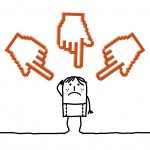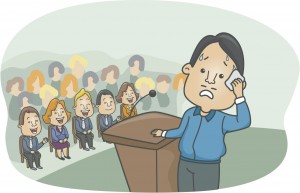
I wonder if the timing of this publication was planned to be so close to the release of DSM-5, but this debut guidance on social phobia (now known as social anxiety disorder) is certainly going to ruffle some feathers. It fuels the discussion about the medicalisation of human personality traits and some will see it as another attempt by the medical community to classify normal behaviour as mental illness.
But is this kind of reaction justified, or is this new guidance simply a set of evidence-based recommendations for recognising, assessing and treating a disabling and persistent condition?

We all get anxious sometimes, but social anxiety disorder is about experiencing a level of anxiety that can regularly disrupt normal life
Social anxiety disorder is said to be one of the most common of the anxiety disorders, affecting something like one in ten people. It involves the persistent fear of certain social situations, such as meeting new people, talking in meetings, eating or drinking while being observed and public performances such as public speaking.
It’s only natural for all of us to get worried about these things from time to time, but people with social anxiety disorder worry about them excessively, and so try to avoid them. This can have a huge impact on their personal lives, their work and their education.
Only half of those with social anxiety disorder seek treatment, even though there are a range of effective therapies to choose from.
Diagnosis in adults
The guideline recommends using the 3-item Mini Social Phobia Inventory (Mini-SPIN) to identify the disorder in adults.
The Mini-SPIN contains 3 items about avoidance and fear of embarrassment that you rate based on the past week. The items are rated using a 5-point Likert scale: 0 = not at all, 1 = a little bit, 2 = somewhat, 3 = very much, 4 = extremely.
- Fear of embarrassment causes me to avoid doing things or speaking to people.
- I avoid activities in which I am the centre of attention.
- Being embarrassed or looking stupid are among my worst fears.
The Mini-SPIN is scored by adding up scores from these 3 item ratings. Scores of 6 or higher on the Mini-SPIN indicate possible problems with social anxiety. Scores this high would generally be followed up with a full diagnostic interview for SAD with a trained mental health professional.
Caring for adults

NICE hopes that adults with social anxiety disorder can choose from a range of treatment options
The guideline recommends a range of treatment options for adults with social anxiety disorder:
- CBT that has been specifically developed to treat social anxiety disorder (based on the Clark and Wells model or the Heimberg model)
- Do not routinely offer group CBT in preference to individual CBT
- For adults who decline CBT and wish to consider another psychological intervention, offer CBT-based supported self-help
- For adults who decline CBT and express a preference for a drug treatment, discuss their reasons for declining CBT and address any concerns
- If the person wishes to proceed with drug treatment, offer an SSRI (escitalopram or sertraline). Monitor the person carefully for side effects
- Short-term psychodynamic psychotherapy that has been specifically developed to treat social anxiety disorder is an option for anyone who declines CBT, self-help or antidepressants, although this treatment is less effective than the other 3.
Caring for children and young people

The guidance recommends proven techniques for detecting and managing social anxiety disorder in children and young people
Recommended treatment options for children are far more limited:
- Offer individual or group CBT focused on social anxiety
- Consider psychological interventions that were developed for adults for young people (typically aged 15 years and older) who have the cognitive and emotional capacity to undertake a treatment developed for adults
Treatments to avoid
NICE also flag up a number of interventions that they suggest are not routinely offered:
- Pharmacological interventions to treat social anxiety disorder in children and young people
- Anticonvulsants, tricyclic antidepressants, benzodiazepines or antipsychotic medication to treat social anxiety disorder in adults
- Mindfulness-based interventions or supportive therapy to treat social anxiety disorder
Professor Mark Baker, Director of the Centre for Clinical Practice at NICE, said:
Social anxiety disorder isn’t about being shy at parties or feeling anxious about a job interview, it’s about experiencing a level of anxiety that can disrupt normal life, interfering with social relationships and affecting performance at work or school. In these cases, it is really important that the individual is able to get the right help.
This guideline includes a number of recommendations to support healthcare professionals to accurately diagnose and manage social anxiety disorder. We hope that the development of NICE guidance in this area will help ensure that those affected by this disorder receive the best possible support.
Nicky Lidbetter, Chief Executive Officer of Anxiety UK, said:
We welcome the development of these guidelines for social anxiety and the recognition that the condition of social anxiety can be extremely disabling for those who experience it.
The recommendations for the treatment of social anxiety disorder will provide GPs and other health professionals with a clear pathway to provide the help and support needed.
Health professionals clearly have a difficult path to tread when it comes to social anxiety disorder. They must avoid over-diagnosing and over-medicating people who do not require treatment, but must also provide a prompt diagnosis and clinically and cost-effective treatment for anyone who really needs it. This new guidance and the wide array of supporting tools from NICE are a step in the right direction at helping support this challenging job.
Links
Social anxiety disorder (main web page). NICE clinical guideline 159, May 2013.
Social anxiety disorder: recognition, assessment and treatment (PDF). NICE clinical guideline 159, May 2013.
Social anxiety disorder pathway. NICE, May 2013.
Social anxiety disorder: Podcast with Gareth Stephens discussing the signs and symptoms of social anxiety and his personal experience of the disorder (8 mins).
Social anxiety disorder: baseline assessment tool (XLS). NICE CG159, 22 May 2013.
Social anxiety disorder: clinical audit tool (XLS). NICE CG159, 22 May 2013.

I’ve suffered with this for years. RT @Mental_Elf: NICE publish first clinical guideline on social anxiety disorder http://t.co/pQW67sc2S6
@Stentington @Mental_Elf I scored 12. That’s not good, is it?
“NICE publish first clinical guideline on social anxiety disorder http://t.co/hwKoDCFv2y” note: interventions are psychological not medical
Only half of those with social anxiety disorder seek treatment, even though effective therapies are available http://t.co/yu07SCYx9C
@Mental_Elf Seeking treatment for social anxiety disorder is THE hardest thing, because it involves talking to people.
@Mental_Elf “Do not routinely offer group CBT in preference to individual CBT” – many people with SAD find 1-1 situations harder.
@NICEcomms recommends CBT based on the Clark & Wells model or the Heimberg model for social anxiety disorder http://t.co/yu07SCYx9C
@NICEcomms recommends individual or group CBT for treating social anxiety in children and young people http://t.co/yu07SCYx9C
NICE publish first clinical guideline on social anxiety disorder – http://t.co/fwB0GtF1ZY
NICE publish first clinical guideline on social anxiety disorder http://t.co/YMFG3mWUbu via @sharethis @Mental_Elf
Read our blog about the new NICE guidance on #SocialAnxietyDisorder http://t.co/yu07SCYx9C
NICE publish first clinical guideline on social anxiety disorder. http://t.co/sPlAqKBpft via @Mental_Elf #socialanxietydisorder #NICE
NICE publish first clinical guideline on social anxiety disorder » The Mental Elf http://t.co/2BMNKI23l9
[…] MentalElf* redesigned its webpage and today’s top item is on Social Anxiety Disorder. The article offers some information that I have never read, including treatments to avoid, like […]
NICE publish first clinical guideline on social anxiety disorder: I wonder if the timing of this publication w… http://t.co/KzY5zZdQ51
NICE publish first clinical guideline on social anxiety disorder http://t.co/Rfxwfm9JSH via @sharethis
In case you missed it today, NICE publish first clinical guideline on social anxiety disorder http://t.co/yu07SCYx9C
@Mental_Elf Another example of throwing Rx at behaviors that would be better served being normalized for people.
http://t.co/scx1i9jiD2
[…] http://www.thementalelf.net/mental-health-conditions/anxiety-disorders/nice-publish-first-clinical-g… […]
It’s an interesting guideline. It kinda implies that people should be talked out of using medication. My understanding is that despite the evidence for medication having limitations, it is not as though the evidence for psychotherapy interventions are not without their flaws and limits too. What are the comparison trials like?
NICE recommends SSRIs for Social Anxiety Disorder – and the reason is …? http://t.co/HPyGwWmzqr via @sharethis
NICE recommends SSRIs for Social Anxiety Disorder – come on, don’t be shy, tell us the reason why … http://t.co/HPyGwWmzqr
[…] Les omtalen i The Mental Elf her […]
[…] A. NICE publish first clinical guideline on social anxiety disorder. The Mental Elf, 23 May […]